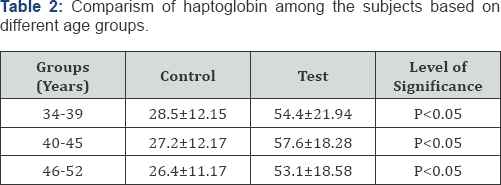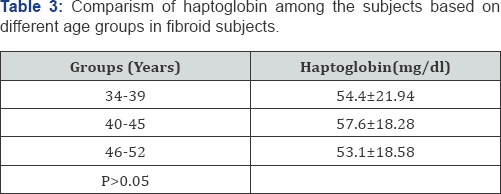Juniper Publishers : Evaluation of Serum Haptoglobin in Fibroid Patients at Elele, Rivers State, Nigeria
JUNIPER PUBLISHERS- JOURNAL OF GYNECOLOGY AND WOMEN’S HEALTH
Journal of Gynecology and Women’s Health-Juniper Publishers
Authored by Obeagu EI*
Abstract
This study was aimed at evaluating of haptoglobin in fibroid patients (test) and non-fibroid patients (control). A total of 111 individuals were selected; 66 fibroid patients and 45 control subjects.Modified nephelometric method of Mispa autoanalyser was used for the assay. The statistical analysis was done using statistical package of social science (SPSS) version 20 and the data analysed with t-test and ANOVA. The results of the study showed that fibroid women has significantly higher (P<0.05) haptoglobin (54.9±19.03 mg/dl) compared to the control (27.03±11.55mg/ dl). It was therefore concluded that there was increased levels of haptoglobin in patients.
Introduction
Haptoglobin (Hp) is reported as a protein in humans encoded by the HPgene. In blood plasma, haptoglobin binds free haemoglobin released from erythrocytes with high affinity and thereby hinders its oxidative activity. Also, it was pointed out that in clinical settings, haptoglobin assay is used to screen for and monitor intravascular haemolytic anaemia [1]. However, the reticuloendothelial system will remove the haptoglobin- haemaoglobin complex from the body, haptoglobin levels will be reduced in haemolytic anaemias.
Fibroids are reported to be benign smooth muscle tumors of the uterus. It has been shown that most women with fibroids are asymptomatic while others may have painful or heavy periods [2]. Fibroids are partially hormone-related and frequently regress after menopause [2]. The prevalence of these benign tumors increases with age [2].
Aim
The aim of the study was to determine the level of haptoglobin in fibroid subjects.
Materials and Methods
Study area
This research was carried out from January to December 2016 on fibroid patients and non-fibroid subjects in Elele, Rivers State, Nigeria.
Subjects
A total of 111 subjects were recruited for the study; sixty six (66) were those who have fibroid (test) while the other 45 were those who do not have fibroid (control). All the subjects were between the age ranges of 34-52 years.
Ethical consideration
Informed consents were obtained from the subjects before carrying the study
Sample collection
A 2ml of venous blood sample was collected from the mid cubital vein in the fore arms of all the subjects who were in sitting position for venepuncture which was carried out with minimal stasis. Blood samples were then carefully transferred into a plain sterile container and allowed to clot for 45 minutes, allowing the serum to be separated.
Determination of haptoglobin using nephelometric immunoassay method
Procedure: The smart card was inserted into the card reader slot and display prompted the addition of R1 and sample. From the R1, 100μl was added and also 5μl of the sample was added into the cuvette and the cuvette placed into the holder, mixed with the machine and after 10 seconds the sample was incubated for 3 seconds. From R2, 100μl was dispensed into the cuvette, mixed and the result read.
Results (Table 1-3)



Discussion
The study showed significant increase in serum haptoglobin (Hp) levels of fibroid patients in relation to the control subjects. According to Abdullah et al. [3] high amounts of haptoglobins in plasma and locally in tumor tissue have been observed in diverse types of malignancies. Prospective studies have suggested that the functions of haptoglobin in cancer are as a biomarker of malignancy, as a regulator of the immune response against tumor cells, and as a facilitator of mestasis, since haptoglobin seems to participate in cell migration and angiogenesis [4]. The result from this study shows that there is a relationship between haptoglobin and fibroid. Haptoglobin levels were higher among those who developed fibroid than the control. The increase in haptoglobins might be due to inflammatory processes associated with fibroid [5-11]. Haptoglobin level should be monitored in the fibroid patients to avert the toxicity of released haemoglobin. This shows that there could be reduced haemolytic anaemia in the patients [12-15].
Conclusion
Haptoglobin levels were increased in fibroid patients and could be attributed to some factors like race and quality of life. Haptoglobin level should be monitored in the fibroid patients to avert the toxicity of released haemoglobin. This could be of diagnostic value in fibroid patient to check intravascular haemolysis and will help in their management.
For more open access journals in JuniperPublishers please click on: https://juniperpublishers.com/
For more articles on Gynecology and Women’s Health please click on: https://juniperpublishers.com/jgwh/
To read more......Fulltext in Gynecology and Women’s Health in Juniper Publishers
https://juniperpublishers.business.site/




Comments
Post a Comment